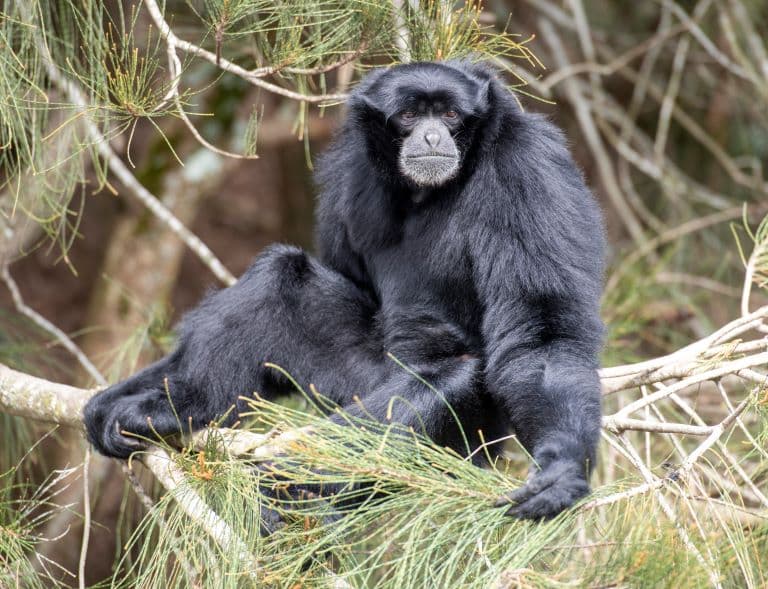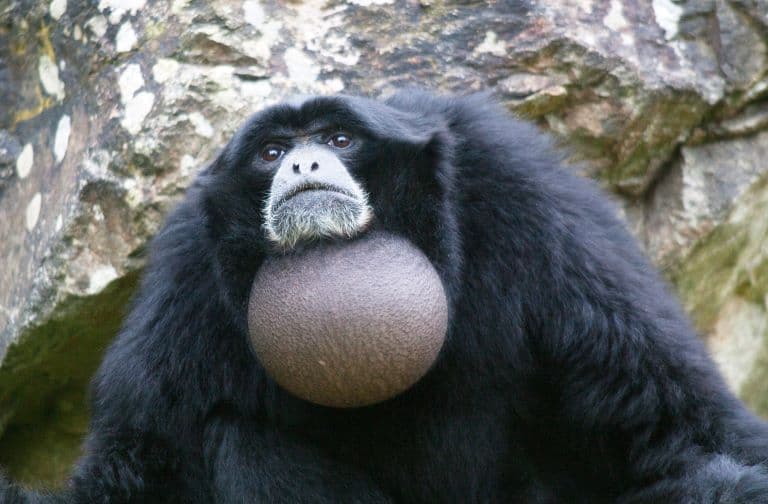Siamang Profile
Ignoring any candidates from various San Francisco subcultures, Disney weren’t far off when they picked an Asian ape to play the “King of the Swingers”. Orangutans are some of the best-known for swinging, or brachiation. But by far the most impressive animals to ever do it have to be the gibbons.
And if there was to be a king of the gibbons, it would be the enormous Siamang.

Siamang Facts Overview
| Habitat: | Semi-deciduous and tropical evergreen forest canopy |
| Location: | Indonesia, Malaysia, Thailand |
| Lifespan: | 44 years in captivity |
| Size: | Around a metre (3 ft) long, up to 1.5 m (4.5 ft) |
| Weight: | 14 kg (31 lb) |
| Colour: | Black with a grey muzzle |
| Diet: | Mostly fruit and leaves, some insects |
| Predators: | Humans, leopards, raptors may be a threat to juveniles |
| Top Speed: | Fast, but not specified |
| No. of Species: | 1 |
| Conservation Status: | Endangered (IUCN) |
Samiangs are the largest gibbon by a wide margin but haven’t sacrificed their elegance in the slightest.
These endangered arboreal acrobats have a few other quirks that set them apart from their kin, including weird hands and necks, the latter of which are used to declare their presence rather loudly.
Their fondness for seedy fruits makes them a significant contributor to forest succession, but unfortunately, human behaviour is counteracting this effect faster than these gibbons can make up for it.
Interesting Siamang Facts
1. They’re gibbons
Gibbons are unusual animals, in that they’re not quite great apes and not monkeys either. Gibbons are what’s known as lesser apes, which is a bit insulting, considering how great they are.
They’re one of the early branches of apes, diverging from human ancestors around 17 million years ago, just a little before the rest of the apes diverged.
Unfortunately for Gibbons, this was after we all lost our tails, so they don’t have one either.
They’re much smaller than the great apes, with simpler brains, and are thought to be less intelligent, but judging from the fun they seem to have in the branches it’s likely that we’re just over-thinkers.
Of all the gibbons, the Siamang has the darkest, densest fur but like its kin, it has Mr. Tickle arms which it uses to great effect.
2. So, they have really long arms
It’s hard to overstate just how long a Siamang’s arms are. They’re significantly longer than its legs, and more than 2.5 times as long as its body.
These are masterpieces of evolution, and gibbons like the Siamang are simply the best at swinging through the branches.
Nothing else comes close to the agility, speed, and sheer showmanship of a gibbon brachiating, seemingly without even looking, and even this large species is superior to any other ape or monkey at this elegant skill.
When moving slowly, they swing lazily from branch to branch, letting go of the previous one as the new one is gripped. But at pace, they can be seen stepping off of ledges, catching branches as they fall and flying through the air effortlessly.
But the most distinguishing characteristic of siamangs is their enlarged throat sac. This is a balloonable skin pouch that can inflate to the size of a human head. 1

3. They have inflatable necks
Okay, there’s another equally distinguishing characteristic that sets this species apart from other gibbons, but it’s not quite as interesting. Siamangs have a pair of toes that are webbed. This is what leads to this species name syndactylus, which essentially means “together finger”.
But back to the sac; males and females alike have an enormous inflatable neck pouch, and this is used as a resonance chamber for some of the cool noises they make. 2

4. They’re super territorial
Males and females are both territorial and engage in echoing duets from the branches, announcing their presence and reminding others to keep away.
All gibbons are excellent singers, but the siamang is outstanding. Rising, bell-like tones are followed by whooping barks and a kind of yapping laugh. Males and females will duet in tune with one another and can sing while swinging at speed.
If warnings aren’t heeded, the male steps forward to confront the intruder and the female will retreat if it’s a large threat or engage if it’s another gibbon. High-speed, Tarzan-like chases through the jungle are common.
5. The two populations have different diets
There are two populations of Siamang, the mainland and the Sumatran groups. Mainland Siamangs tend to eat primarily leaves, but their island relatives have grown to prefer fruits.
Both populations supplement these diets with handfuls of insects here and there, but the stark differences in feeding habits suggest a wide range of flexibility in the species. 3

6. They’re seed dispersers
And of course, the fruit-eating Siamangs are important seed dispersers. Undigested seeds from the fruits they eat make their way to the forest floor and help spawn the next generation of fruit trees.
The Siamang’s active lifestyle helps the plants get their seeds more than 350 metres from the tree itself, aiding in forest recovery and succession. 4
7. They’re running out of space
Despite all they do for forest conservation, human interference is countering it far faster than the Siamang can plant.
Forest conversion, mining, road construction, and the opportunistic poaching for consumption and the illegal pet trade all are contributing to the decline of the Siamang. It’s now listed as Endangered by the IUCN, and the decline appears to be accelerating.
It’s possible that 60% to 100% of the suitable Sumatran habitat for this large gibbon will be gone by the middle of the century, and in Thailand, things are only marginally better.
Based on the recent data provided by Global Forest Watch, the rate of forest loss on Sumatra has accelerated over the last five years and, if that pace continues, it is possible to project a loss of nearly 60% of suitable forest habitat by mid-century.
Palm oil and rubber are two of the main culprits for deforestation in this region of Southeast Asia, and Indonesian islands are some of the worst affected.
San Diego Zoo, one of the world’s leading captive breeding and conservation institutions, is heavily involved in their protection, and the San Diego Zoo Wildlife Alliance is a great place to start for people who want to support Siamang conservation work.
Siamang Fact-File Summary
Scientific Classification
| Kingdom: | Animalia |
| Phylum: | Chordata |
| Class: | Mammalia |
| Order: | Simiiformes |
| Family: | Hylobatidae |
| Genus: | Symphalangus |
| Species: | syndactylus |
Fact Sources & References
- Andrew Eastridge, “Symphalangus syndactylus siamang”, Animal Diversity Web.
- “symphalangus syndactylus”, Honolulu Zoo Society.
- Metro Richmond Zoo (2020), “Siamang Call”, YouTube.
- Author Name (2022), “Role of siamang (Symphalangus syndactylus) as seed dispersal agent in a Sumatran lowland tropical forest”, Biodiversitas Journal of Biological Diversity.
